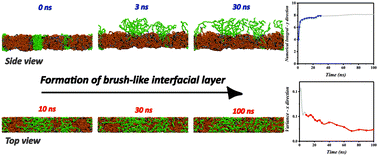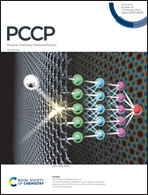Hydrophilic dangling chain interfacial segregation in polyurethane networks at aqueous interfaces and its underlying mechanisms: molecular dynamics simulations†
Abstract
Polymer networks with hydrophilic dangling chains are ideal candidates for many submerged applications, e.g., protein non-adhesive coatings with non-fouling behavior. The dangling chains segregate from the polymer network towards the water and form a brush-like structure at the interface. Several factors such as the polymer network structure, dangling chain length, and water/dangling chain interaction may all affect the interfacial performance of the polymer. Therefore, we employed a Martini based coarse-grained (CG) molecular dynamics (MD) simulation to elucidate the influences of the abovementioned parameters on dangling chain interfacial segregation. We built up several polyurethane (PU) networks based on poly(tetra methylene glycol) (PTMG), as a macrodiol, and methoxy poly(ethylene glycol) (mPEG), as a dangling chain, with varying molecular weights. We found out that the macrodiol/dangling chain length ratio considerably smaller than one impedes the migration of dangling chains towards the water interface, while the dangling chain hydrophilicity and length determine the polymer interfacial layer density/thickness. Then, we artificially changed the dangling chain affinity to water from an intermediate to a very attractive water/dangling chain interaction. We justified that a brush-like structure forms in two consecutive steps: first, a longitudinal, and then a lateral migration of dangling chains in water. The latter step results in a uniform interfacial layer over the polymer interface that mainly occurs in the case of the attractive water/dangling chain interaction.



 Please wait while we load your content...
Please wait while we load your content...